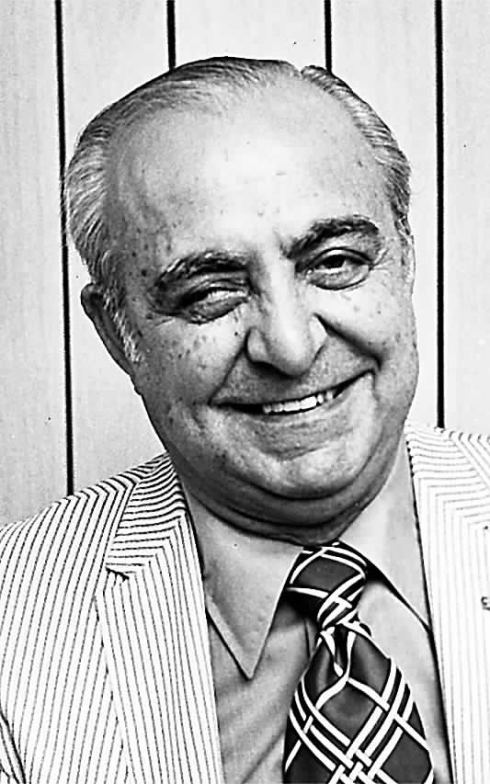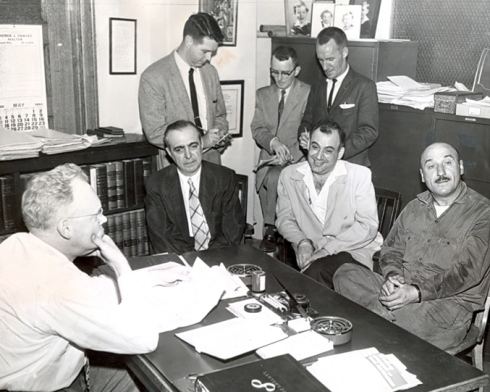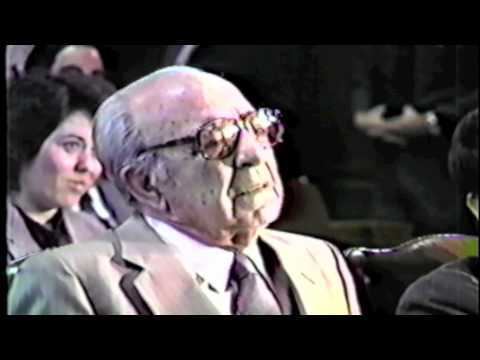Cause of death Heart attack Resting place Forty Fort Role Boss | Name Russell Bufalino Citizenship Italian | |
 | ||
Nationality Sicilian, Italian, American Occupation Crime boss, Mafioso, Mobster, Bootlegger, Businessman, Racketeer Died February 25, 1994, Kingston, Pennsylvania, United States | ||
The quiet don russell bufalino
Russell A. Bufalino also known as "McGee" and "The Old Man" (September 25, 1903 – February 25, 1994) was a Sicilian-born American mafioso who became the boss of the Northeastern Pennsylvania crime family (also known as the Bufalino crime family) which he ruled from 1959 to 1989. Despite being the boss of a small crime family, Bufalino was a significant influence in the national Cosa Nostra criminal organization.
Contents
- The quiet don russell bufalino
- Early years
- Criminal career in New York
- Northeastern Pennsylvania crime family
- Apalachin mob meeting
- Change of family leadership
- Family prosperity
- Extortion conviction
- Attempted murder conviction
- Decline and death
- References

Early years

Born in Montedoro, Sicily, as Rosario Alberto Bufalino, Bufalino's family immigrated to Buffalo, New York, where he became a criminal during his teenage years. Bufalino worked alongside many Buffalo mobsters, some of whom would become top leaders in the Buffalo crime family and other future Cosa Nostra families along the East Coast of the United States. These relationships proved very helpful to Bufalino in his criminal career. Family and clan ties were important to Sicilian-American criminals; they created a strong, secretive support system that outsiders or law enforcement could not infiltrate. A significant friendship was with his first boss, John C. Montana. An immigrant from Montedoro, Montana was an early powerful figure in the Buffalo family.
Criminal career in New York

As a young man, Bufalino involved himself in traditional underworld rackets such as gambling, extortion, robbery, theft and debt collection. By the time Bufalino reached his mid-20s, his criminal record showed arrests for petty larceny, receiving stolen goods, conspiracy to obstruct justice, drug dealing, and fencing stolen jewelry. When Prohibition was enacted in 1919, Bufalino quickly became involved in the lucrative new business of bootlegging.
Northeastern Pennsylvania crime family
In the early 1920s, Bufalino started working with Joseph Barbara, another young upstate New York bootlegger. Both men were Sicilian and shared friends in the Buffalo underworld. Bufalino soon moved with his new wife to Endicott, New York, in Barbara's territory. Bufalino and Barbara built a close working relationship throughout the 1930s. In 1940, when Barbara became boss of the Northeastern Pennsylvania crime family, he named Bufalino as underboss. Bufalino moved to Kingston, Pennsylvania, a central location that let him supervise family operations.
The Northeastern Pennsylvania crime family was fairly small; at its peak, it contained between only 30 to 40 made men, or full members. The family controlled organized crime activities in Pittston, Scranton and Wilkes-Barre, Pennsylvania, and upstate New York areas. The family also had operations in parts of New Jersey, Ohio and South Florida. It was one of the smallest crime families on the east coast; however, it had strong ties with the larger, more powerful Buffalo crime family and New York Bonanno crime family. These ties gave Barbara more influence in the Mafia Commission, which regulated all the crime families. As underboss, Bufalino had the chance to meet some of the top Cosa Nostra bosses.
Apalachin mob meeting
In 1957, Angelo Calciano, leader`of Buffalo crime family boss Stefano Magaddino asked Barbara to let him host a major American Mafia summit at Barbara's ranch house in rural Apalachin, New York. Aware that a local state trooper had been watching the property, Barbara had reservations about holding the meeting there. However, since Magaddino was insistent, Barbara agreed to the Apalachin Conference. Bufalino helped organize the meeting, communicating with delegates, ordering the food and Italian delicacies, and arranging hotel accommodations for the guests. On November 14, 1957, 101 top American mobsters representing all 27 U.S. crime families, along with representatives from Canada and Sicily, arrived in Apalachin. Attendees included New York family bosses Vito Genovese, Carlo Gambino and Joseph Bonanno (though his autobiography A Man of Honor claimed he was not there), plus boss Sam Giancana of the Chicago Outfit, and Santo Trafficante Jr., family boss of Tampa, Florida.
However, the meeting soon ended in disaster. State Trooper Edgar D. Croswell noticed Barbara's son making reservations for the mobsters at a local hotel. His suspicions raised, Croswell drove to the Barbara ranch and immediately saw that a mob meeting was getting ready to start. Soon federal and state agents had surrounded the property and set up roadblocks. Alerted by a deliveryman, the mobsters began to flee. Some ran into the woods while others nonchalantly tried to drive away. More than 69 well-known mobsters were arrested that day, including Bufalino. However, as with most of those arrested, all charges were eventually dropped.
Change of family leadership
The Apalachin fiasco was a huge blow to the secrecy of organized crime in America. It also took a tremendous toll on Barbara's reputation in the underworld. This humiliation, combined with increased law enforcement and media scrutiny, convinced Barbara to retire in 1958. By the end of the year, Bufalino had become the de facto boss of the Northeastern Pennsylvania crime family. With Barbara's death in June 1959, the Mafia Commission recognized Bufalino as the official family boss. Bufalino soon became the epitome of the well-respected, low-key, cunning and rational mob boss who knew how to delegate authority and disguise his true power and influence. He was well liked and never flaunted his wealth and power.
In October 1963, a low-level member of the New York Genovese crime family, Joseph Valachi, testified on the inner workings of La Cosa Nostra. The Senate Select Committee on Improper Activities in Labor and Management had been holding hearings since 1957 on ties between organized crime and the Teamsters union. In 1960, these hearings transferred to the Permanent Subcommittee on Investigations of the U.S. Senate Committee on Government Operations. However, Valachi proved to be the Permanent Subcommittee's greatest star. Millions of Americans watched the hearings on television as Valachi named the top Mafia bosses in the U.S., including Bufalino. The Committee later described Bufalino as "...one of the most ruthless and powerful leaders of the Mafia in the United States."
It was also alleged that Bufalino had close contacts in the Central Intelligence Agency (CIA) and took part in the Cuban Project, the Cosa Nostra - CIA operation to assassinate Cuban president Fidel Castro. Some conspiracy theorists believe that Bufalino was involved in an alleged Cosa Nostra plot to assassinate President John F. Kennedy. However, there is no credible evidence that Bufalino tried to kill Kennedy.
Family prosperity
Throughout the 1960s and 1970s, Bufalino maintained major criminal interests in illegal gambling, loansharking, and labor racketeering. Much of the family's original power came from its control of coal mining and trucking union locals in Pennsylvania. Bufalino continued to maintain lucrative interests within the industry and control over its most influential unions. However, the family also had legitimate investments in real estate and various businesses. In 1974, Bufalino started expanding his family's influence into Upstate New York. The death of Buffalo family boss Stefano Magaddino had left that family divided and its power diminished. Bufalino sent family members into the upstate region to set up gambling operations and to check on possible investments within the construction industry.
By the 1970s, Bufalino had become a senior mafioso within Cosa Nostra. It was alleged that in the early 1970s Bufalino was appointed as an "interim boss" or type of sanctioned overseer of the Genovese crime family by the Commission at a time when that crime family was experiencing internal difficulties.
Congressman Dan Flood, who served northeastern Pennsylvania in the U.S. House of Representatives from 1945 to 1980, was investigated by at least eight separate U.S. Attorney's offices and had 175 possible cases pending against him. A so-called 'muscler', Flood used his influence to direct federal contracts to people and corporations in exchange for cash kickbacks.
The 'Flood-Medico-Bufalino Triangle' was one example. Medico Industries of Plains Township, Pennsylvania, received, with Flood's help, a $3,900,000 Department of Defense contract to produce 600,000 warheads for use in the Vietnam War. Bufalino, who frequented Medico offices, was an associate of general manager William 'Billy' Medico and president Philip Medico, who was a caporegime in the Bufalino family. The FBI discovered that Flood would often travel in the Medico Industries jet. Flood was eventually censured for bribery and resigned from the House in 1980.
Extortion conviction
In 1977, Bufalino was indicted on extortion charges. He had threatened a man who owed $25,000 to a diamond fence associated with the Bufalino family. The debtor, who had been under law enforcement surveillance, decided to testify against Bufalino and enter the Witness Protection Program. As soon as Bufalino was indicted, he took steps to reduce the possibility of further criminal charges. He named consigliere Eddie Sciandra as acting boss and removed himself from the day-to-day operations of the family. On August 8, 1978, Bufalino was convicted and sentenced to four years imprisonment for his part in the extortion attempt. Regarding an incident during the sentencing, Bufalino stated to the court "If you had to deal with an animal like that, Judge, you'd have done the same damn thing." Once in prison, Bufalino used his longtime driver and aide to maintain his personal affairs and deliver orders to the acting leaders.
Attempted murder conviction
During the 1980s, federal law enforcement around the country continued their onslaught of investigations aimed at the upper echelon of La Cosa Nostra and their crime families. Many indictments and trials ensued, followed by several high level convictions such as those of the New York bosses in the famous Mafia Commission Trial of 1986. The successful prosecution of New York's top Mafia bosses in the mid-1980s seem to somewhat galvanize and motivate law enforcement across the United States as further investigations and media scrutiny were brought to bear on top Mafia members from across the United States.
After his release from prison in the early 1980s, Bufalino also became a high-priority target for federal investigators. Bufalino was soon indicted for plotting to murder the debtor who had testified against him in 1977. Before the extortion trial, Bufalino had discovered the witness' hiding place and ordered hitman Jimmy "The Weasel" Fratianno to kill him. Unfortunately for Bufalino, Fratianno was a government informant. Fratianno later told Bufalino that he could not locate the witness. Now Fratianno was brought forward to testify against his boss. Bufalino was convicted and sentenced to 10 years in prison.
Decline and death
With Bufalino again in prison and the family under federal investigation, the organization's strength began to wane. Many family members were looking forward to retirement. Bufalino himself was now in his 80s and in ill health. In 1989, operation of the remainder of the Northeastern family was given to Billy D'Elia.
At the end of the decade, Bufalino was released from prison. Despite his advanced age, he continued to be a significant influence on Cosa Nostra activities and was continually watched by federal authorities. On February 25, 1994, Bufalino died of natural causes at Nesbitt Memorial Hospital in Kingston, Pennsylvania, at age 90. He is buried in Denison Cemetery in Forty Fort, Pennsylvania.
